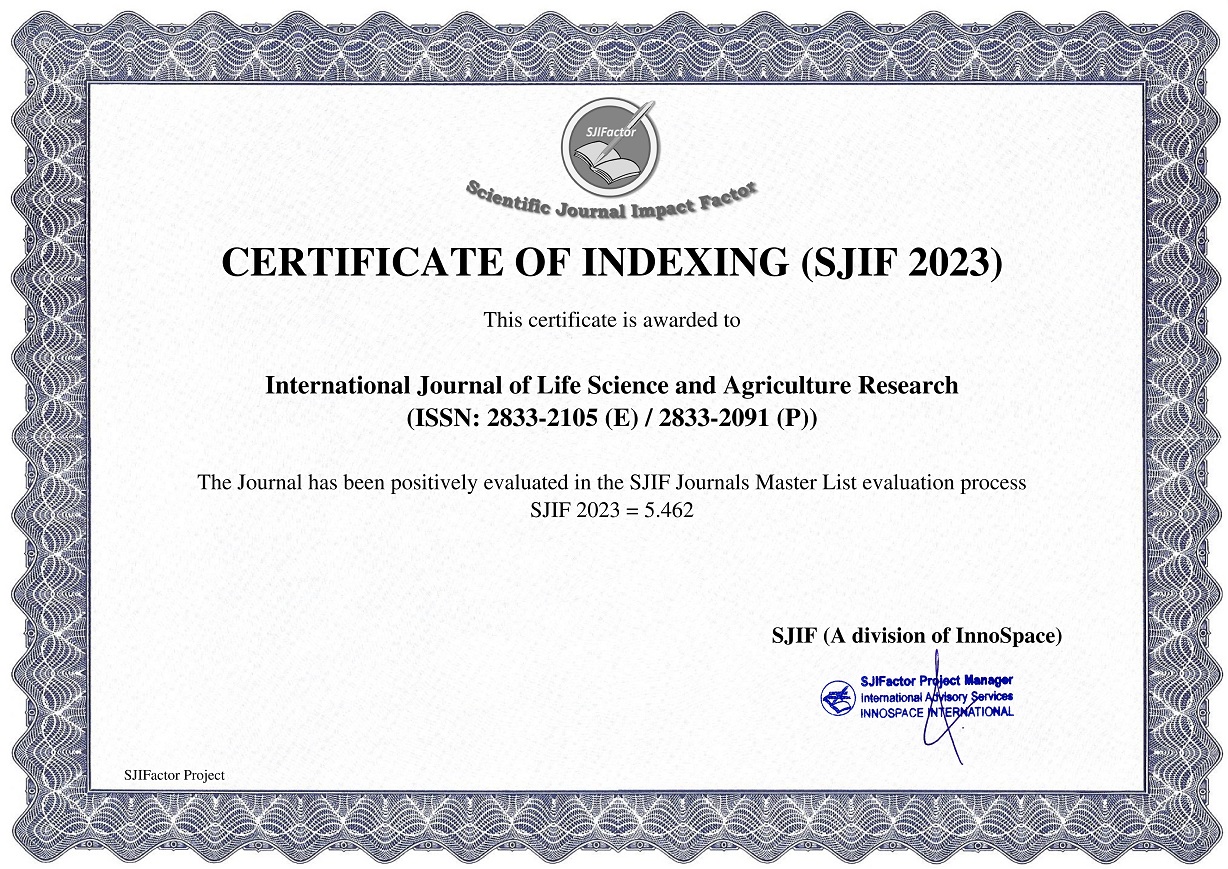Genetic Analysis of Productive Performance in New Zealand White Rabbits
DOI:
https://doi.org/10.55677/ijlsar/V02I06Y2023-01Keywords:
Heritability, genetic, common-litter and phenotypic correlations, breeding values.Abstract
In this study, the genetic parmeters of the New Zealand white (NZW) rabbit were evaluated and clarified, including heritability and the common-litter effect, as well as genetic, common-litter, phenotypic correlations, and breeding values. For this purpose, 656 rabbits were kept at the Sakha research farm, for two years. A multi-trait animal model was used to analyze the body weights and relative growth rates data. Heritability estimations (h2a) for various body weights ranged from 0.15 to 0.30 and were low to moderate. The minimum estimate of h2a for relative growth rates at 4 to 6 weeks was 0.13, and the maximum estimate of h2a for relative growth rates at 10 to 12 weeks was 0.24. Moderate to high and positive genetic correlation (rg) between body weights, 0.36 to 0.73. rg estimates between relative growth rates ranged from moderate (0.45) to high (0.84) and positive. Common-litter correlation (rc) between body weights ranged from moderate (0.32) to high (0.71) and positive. rc estimates between relative growth rates ranged from moderate (0.43) to high (0.71) and positive. The phenotypic correlation (rp) between body weights was moderate (0.41) to high (0.80) and positive. rp estimates between the relative growth rates were high and positive. The estimated ranges of breeding values were 175.07, 263.89, 299.48, 267.78, and 279.86 for 4, 6, 8, 10, and 12 weeks, respectively. While were 24.56, 27.04, 31.80, 35.14, and 29.28 during the period of 4-6, 6-8, 8-10, 10-12, and 4-12 weeks, respectively.
References
Abdel-Kafy, E.; El-Deighadi, A.S.; Shabaan, H.M.; Ali, W.H.A.; Sabra, Z.E.A. and Farid, A., 2021. Genetic Evaluation of Growth Traits in New Synthetic Rabbit Line in Egypt. Open J. Agric. Res., 1: 62-73.
Broody, S., 1945. Bioenergetics and growth. Reinhold Pub Crop NY, USA.
El-Badawy, E. A. Faten, 2015. Improving quantitative traits in local rabbits. Ph. D. Thesis, Fac. Agric., Cairo Univ. Egypt.
El-Deghadi, A.S., 2005. Genetic evaluation for some productive traits in rabbits.Ph.D. Thesis, Fac. Agric., Moshtohor, Zagazig Univ., Banha Branch, Egypt.
El-Deighadi, A.S., Ibrahim M. K., 2017. Genetic aspects of post-weaning for growth traits in New Zealand white rabbits. Egyptian Journal of Rabbit Science., 27(2), 507-521.
El-Deghadi, A.S., Ibrahim M. K., 2018. Selection indices for improving body weight in Gabali rabbits. Egyptian Poultry Science Journal.,38: 1115-1126. https://doi.org/10.21608/ epsj.2018.22904.
El-Deghadi A., 2019. Genetic evaluation of some doe, litterand laction-traits of New Zealand white rabbits. Egypt J Rabbit Sci; 29(1):23–43; http://doi.org/10.21608/EJRS.2019.45672
El-Deghadi, A.S., Elkassas, N.EM, Arafa, MM, Seif El-Naser, M.I., 2022. Evaluation Of Productive Performance In Synthetic Maternal Line (Apri Rabbits) Under Egyptian Conditions. SINAI Journal of Applied Sciences 11 (4) 2022 727-738, Available online at www.sinjas.journals.ekb.eg.
El-Raffa A. M., 2005. Genetic and non–genetic relationships between growth performance and litter size traits in a maternal rabbit line. Egyptian Poultry Science 25, 1203-1215.
Farouk S.M., Khattab A.S., Noweir, A., Ghavi Hossein-Zadeh, N., 2022. Genetic analysis of some productive and reproductive traits in New Zealand White rabbits. World Rabbit Sci., 30: 141-146. https://doi.org/10.4995/wrs.2022.15939.
García, M..L,. Argente, M..J., 2020. The Genetic Improvement in Meat Rabbits See discussions, stats, and author profiles for this publication at: https:// www.researchgate.net/publication /346205479.
Lukefahr S.D., Cheeke P.R., 1991. Rabbit project development strategies in subsistence farming systems. 2. Research applications. World Animal Rev., 69, 60-70.
Lukefahr, S.D., Hohenboken, W.D., Cheeke, P.R., Patton, N.M., 1981. Milk production and litter growth traits in straight bred and crossbred rabbits. J. Appl. Rabbit Res., 4(2), 35-40.
Lukefahr S. D., Odi, H. B., Atakora J. K. A., 1996. Mass selection for 70-day body weight in rabbit. Journal of Animal Science 74, 1481-1489.
McNitt J. I ., Lukefahr S., D., 1996. Genetic and environmental parameters for post-weaning growth traits of rabbits using an animal model, 6th World Rabbit Congress, Toulouse. France 2,325-329.
MEYER, K. 2007. A tool for mixed model analyses in quantitative genetics by restricted maximum likelihood (REML). J. Zhejiang Univ. Sci., B 8 (2007), pp. 815-821. doi:10.1631/jzus.2007.B0815.
Moustafa, H.A., 2014. Genetic evaluation of some economic traits in a maternal line of rabbits, Ph.D. Thesis, Fac. Agric., .Alex. Univ., Alex., Egypt.
Ossa SG. Mejoramiento genético animal aplicado a los sistemas de producción de carne. 2017. Editorial Universidad Nacional de Colombia, Bogotá, Colombia, pp 150–3.
Rym Ezzeroug, R.B., Maria, J.A., Ali, B., Samir, D., Zoulikha, B., Djamal, T., Nassima, B. and Maria de la Luz García, 2020. Genetic correlations for reproductive and growth traits in rabbits.Can. J. Animal Sci., 100.
SAS., 2003. SAS Online Doc 9.13 SAS Institute Inc., Cary, NC, USA.
Youssef, M. K., Farid A., Gad-Alla, S. A., Abo-Warda, M. A., 2009. Genetic evaluation for post weaning body weight traits in three genetic groups of rabbits under Egyptian conditions. 5th International Poultry Conference, 10-13 March 2009. Taba Egypt.





